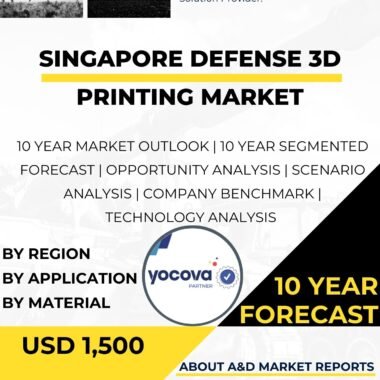Description
The South Korea defense 3D printing market is a rapidly expanding segment within the nation’s defense industry. 3D printing, also known as additive manufacturing, is a revolutionary technology that enables the creation of three-dimensional objects by adding material layer by layer based on digital designs. This article provides an in-depth analysis of the current state, growth drivers, challenges, key players, and future prospects of the South Korea defense 3D printing market.
The historical context of the South Korea defense 3D printing market can be traced back to the nation’s desire to enhance its defense capabilities and reduce reliance on traditional manufacturing methods. As South Korea faced complex security challenges and the need to modernize its armed forces, the adoption and development of 3D printing technology became crucial for the defense industry.
In the current landscape, the South Korea defense 3D printing market has witnessed significant growth and diversification. It encompasses a wide range of applications, including prototyping, rapid tooling, spare parts manufacturing, and even the production of complex components for military equipment.
One of the primary growth drivers for the South Korea defense 3D printing market is the country’s focus on indigenization and developing homegrown defense technologies. The government’s commitment to fostering domestic defense capabilities has led to increased investments in research and development, driving innovation in 3D printing technology.
Moreover, 3D printing offers numerous advantages over traditional manufacturing methods in the defense sector. It enables rapid prototyping, reducing development time and costs for new military equipment. Additionally, it allows for on-demand manufacturing of spare parts, which is crucial for maintaining the readiness of military assets.
Furthermore, South Korea’s strategic location in Northeast Asia and the presence of potential adversaries underscore the importance of having a robust defense 3D printing infrastructure. 3D printing can enhance the agility and responsiveness of the defense industry, allowing for faster innovation and customization of military equipment.
The South Korea defense 3D printing market also benefits from the nation’s strong manufacturing capabilities and skilled workforce. With a well-established manufacturing sector, South Korea has the necessary expertise to leverage 3D printing technology effectively in the defense industry.
Additionally, the South Korean government’s continued focus on promoting innovation and emerging technologies further drives the adoption of 3D printing in the defense sector. Supportive policies and financial incentives encourage defense companies to explore and invest in 3D printing solutions.
However, the market also faces several challenges. One of the primary challenges is the need for standardization and certification of 3D printed components for military use. Ensuring the quality and reliability of 3D printed parts is essential to meet stringent defense standards and regulations.
Moreover, 3D printing technology is continually evolving, and defense companies must keep up with the latest advancements to fully capitalize on its potential. This requires continuous investment in research and development to develop cutting-edge 3D printing capabilities.
Additionally, intellectual property and security concerns may arise in the defense 3D printing market. The ability to reproduce military equipment using 3D printing could raise issues related to counterfeit parts and unauthorized replication.
To address these challenges and ensure sustained growth, South Korea’s defense industry must prioritize research and development in 3D printing technology. Investing in advanced engineering capabilities will enable the country to develop state-of-the-art 3D printing solutions, maintaining a competitive edge in the global market.
Furthermore, fostering collaboration between the defense industry, academia, and research institutions can drive innovation and knowledge exchange in 3D printing technology.
The South Korean government’s continued support for the defense 3D printing market is crucial for promoting growth and innovation. Financial backing for research and development initiatives, as well as procurement programs for 3D printed components, will drive the adoption of 3D printing in the defense industry.
Moreover, promoting a skilled workforce and providing training and education in 3D printing technology will enhance the local talent pool and create a sustainable ecosystem for the South Korea defense 3D printing market.
In conclusion, the South Korea defense 3D printing market is a rapidly expanding segment within the nation’s defense industry. Driven by the country’s focus on indigenization, developing homegrown defense technologies, and leveraging the advantages of 3D printing in military applications, the market continues to grow steadily. However, challenges related to standardization, technology adoption, and security concerns require proactive measures from the government and the defense industry to ensure sustained growth and competitiveness in the global market. By investing in research and development, fostering collaboration, and promoting a skilled workforce, South Korea can strengthen its position as a key player in the global defense 3D printing market and enhance its overall defense capabilities.




